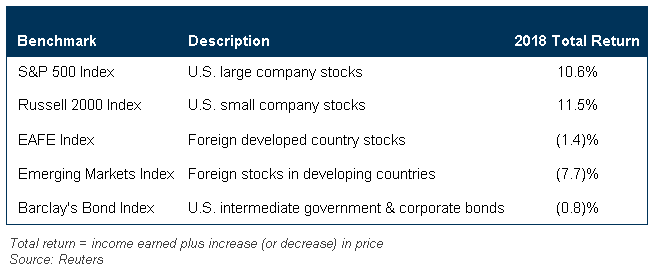Market Commentary ~ October 2018

Continuing Progress
U.S. equity markets rose since our July report, buoyed by ongoing economic expansion and strong corporate profit growth. Foreign stock markets were disappointing, reflecting less vigorous economic conditions abroad and uncertainty about U.S. trade policy. With interest rates trending higher and bond prices thereby lower, most fixed income benchmarks posted lackluster returns. Year-to-date performance for various asset classes is summarized below. A blend of these results provided a favorable return for most balanced portfolios.
Bartlett is very pleased by the continuing progress. We anticipated this resilience in commentaries sent during market setbacks in recent years, providing reassurance amid a “recession scare” in 2016 and again earlier this year during a brief 10% selloff prompted by inflation data and tariff policy.
Rising Optimism, Increasing Risk
The late Sir John Templeton, a legendary investor, memorably described the cycles inherent in equity markets.
“Bull markets are born in pessimism, grow on skepticism, mature on optimism and die on euphoria. The time of maximum pessimism is the best time to buy, and the time of maximum optimism is the best time to sell.”
Warren Buffett likewise signaled the importance of temperament in describing his success.
“We simply attempt to be fearful when others are greedy and to be greedy only when others are fearful.”
The wisdom of these investing giants seems especially timely now when we consider recent good news.
- The NFIB reported a 35-year high in its Small Business Optimism Index.
- The Conference Board reported an 18-year high in its Index of Consumer Confidence.
- In the latest monthly update of the Index of the Leading Economic Indicators, further progress prompted the Director of Research for The Conference Board to opine “At this stage of a maturing business cycle in the U.S., it doesn’t get much better than this.”
It all sounds so encouraging. However, rising optimism should be viewed cautiously by investors. History clearly validates Templeton’s script; rising stock market cycles begin amid pessimism when prevailing business conditions seem so bleak (i.e. March 2009) and markets peak when the economic outlook seems most promising.
What Could Go Wrong?
There are currently no warning signs of a U.S. recession starting in the next year. As noted above, the Index of Leading Economic Indicators recently registered a new high, portending continuing growth. While very reassuring, we recognize the limitations of this barometer, because it is not predictive beyond 12-15 months. Of key long-term importance is that we are in the midst of a major transition at the Federal Reserve, which recently increased its policy interest rate for the eighth time since 2016. This “normalization” of interest rates means higher costs for borrowers. We are seeing some notable initial fallout, with a slowdown in regional housing markets here in the U.S., and a selloff in many emerging country stock markets. As we noted in our July report, there have been eleven rising interest rate cycles since 1950 – these are referred to as “tightening” by Fed watchers – and nine of these cycles ended in recessions. Much has been written about other factors impacting the economic outlook, such as tariff policies and political polarization, but we deem the normalization of interest rates to be of paramount importance as we look out 2-3 years. Bartlett thinks higher interest rates are necessary because the economy is operating near full employment with very little slack, so the Fed must remain vigilant about potential inflationary pressures.
Outlook & Strategy
Our goal is to deliver “all weather” investment performance, with growth achieved in good times while fallout from significant market setbacks is moderated. We think this calls for a renewed focus on proven investment principles: rebalancing asset allocation based on policy guidelines, diversifying broadly, emphasizing quality holdings with less volatility, and selected profit-taking in positions that have exceeded expectations. We think the best safeguards are adequate liquidity (cash and short-term bonds) for anticipated 12-18 month portfolio withdrawals, and appropriate balance (bonds and alternative investments) to control risk relative to long-term objectives. With these protections in place, stock market selloffs should not disrupt financial plans. In fact, returning to Buffett’s wisdom, setbacks could be times of opportunity – rebalancing to higher equity allocation as opportunities develop – rather than peril.
Financial Planning Update
Holly Mazzocca was recently accredited as a CERTIFIED FINANCIAL PLANNERTM, having passed her final examination in July. Holly is our 5th CFP®. Bartlett also has 12 Chartered Financial Analysts and two Certified Public Accountants, giving us the professional depth to handle all facets of wealth management and financial planning.
Final Comments
The firm’s client retention rate for 2018 is at 99% as of midyear, and we continue to add new business at a steady pace. Do you know someone who might appreciate having Bartlett in their corner? If so, please recommend us to others who could benefit from Bartlett’s investment management andfinancial planning services.


